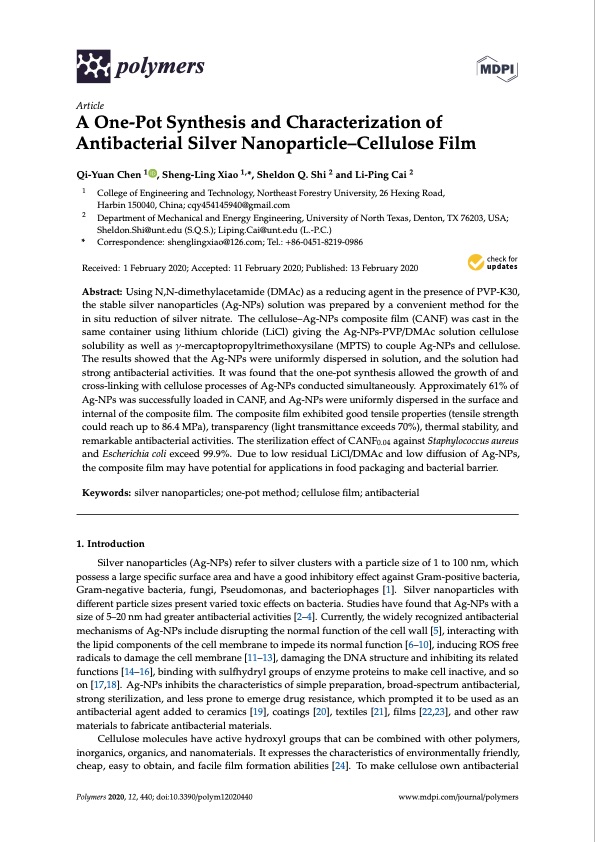
PDF Publication Title:
Text from PDF Page: 001
polymers Article A One-Pot Synthesis and Characterization of Antibacterial Silver Nanoparticle–Cellulose Film Qi-Yuan Chen 1 , Sheng-Ling Xiao 1,*, Sheldon Q. Shi 2 and Li-Ping Cai 2 1 College of Engineering and Technology, Northeast Forestry University, 26 Hexing Road, Harbin 150040, China; cqy454145940@gmail.com Department of Mechanical and Energy Engineering, University of North Texas, Denton, TX 76203, USA; Sheldon.Shi@unt.edu (S.Q.S.); Liping.Cai@unt.edu (L.-P.C.) 2 * Correspondence: shenglingxiao@126.com; Tel.: +86-0451-8219-0986 Received: 1 February 2020; Accepted: 11 February 2020; Published: 13 February 2020 Abstract: Using N,N-dimethylacetamide (DMAc) as a reducing agent in the presence of PVP-K30, the stable silver nanoparticles (Ag-NPs) solution was prepared by a convenient method for the in situ reduction of silver nitrate. The cellulose–Ag-NPs composite film (CANF) was cast in the same container using lithium chloride (LiCl) giving the Ag-NPs-PVP/DMAc solution cellulose solubility as well as γ-mercaptopropyltrimethoxysilane (MPTS) to couple Ag-NPs and cellulose. The results showed that the Ag-NPs were uniformly dispersed in solution, and the solution had strong antibacterial activities. It was found that the one-pot synthesis allowed the growth of and cross-linking with cellulose processes of Ag-NPs conducted simultaneously. Approximately 61% of Ag-NPs was successfully loaded in CANF, and Ag-NPs were uniformly dispersed in the surface and internal of the composite film. The composite film exhibited good tensile properties (tensile strength could reach up to 86.4 MPa), transparency (light transmittance exceeds 70%), thermal stability, and remarkable antibacterial activities. The sterilization effect of CANF0.04 against Staphylococcus aureus and Escherichia coli exceed 99.9%. Due to low residual LiCl/DMAc and low diffusion of Ag-NPs, the composite film may have potential for applications in food packaging and bacterial barrier. Keywords: silver nanoparticles; one-pot method; cellulose film; antibacterial 1. Introduction Silver nanoparticles (Ag-NPs) refer to silver clusters with a particle size of 1 to 100 nm, which possess a large specific surface area and have a good inhibitory effect against Gram-positive bacteria, Gram-negative bacteria, fungi, Pseudomonas, and bacteriophages [1]. Silver nanoparticles with different particle sizes present varied toxic effects on bacteria. Studies have found that Ag-NPs with a size of 5–20 nm had greater antibacterial activities [2–4]. Currently, the widely recognized antibacterial mechanisms of Ag-NPs include disrupting the normal function of the cell wall [5], interacting with the lipid components of the cell membrane to impede its normal function [6–10], inducing ROS free radicals to damage the cell membrane [11–13], damaging the DNA structure and inhibiting its related functions [14–16], binding with sulfhydryl groups of enzyme proteins to make cell inactive, and so on [17,18]. Ag-NPs inhibits the characteristics of simple preparation, broad-spectrum antibacterial, strong sterilization, and less prone to emerge drug resistance, which prompted it to be used as an antibacterial agent added to ceramics [19], coatings [20], textiles [21], films [22,23], and other raw materials to fabricate antibacterial materials. Cellulose molecules have active hydroxyl groups that can be combined with other polymers, inorganics, organics, and nanomaterials. It expresses the characteristics of environmentally friendly, cheap, easy to obtain, and facile film formation abilities [24]. To make cellulose own antibacterial Polymers 2020, 12, 440; doi:10.3390/polym12020440 www.mdpi.com/journal/polymersPDF Image | One-Pot Synthesis of Antibacterial Silver Nanoparticle

PDF Search Title:
One-Pot Synthesis of Antibacterial Silver NanoparticleOriginal File Name Searched:
polymers-12-00440-v2.pdfDIY PDF Search: Google It | Yahoo | Bing
Turbine and System Plans CAD CAM: Special for this month, any plans are $10,000 for complete Cad/Cam blueprints. License is for one build. Try before you buy a production license. More Info
Waste Heat Power Technology: Organic Rankine Cycle uses waste heat to make electricity, shaft horsepower and cooling. More Info
All Turbine and System Products: Infinity Turbine ORD systems, turbine generator sets, build plans and more to use your waste heat from 30C to 100C. More Info
CO2 Phase Change Demonstrator: CO2 goes supercritical at 30 C. This is a experimental platform which you can use to demonstrate phase change with low heat. Includes integration area for small CO2 turbine, static generator, and more. This can also be used for a GTL Gas to Liquids experimental platform. More Info
Introducing the Infinity Turbine Products Infinity Turbine develops and builds systems for making power from waste heat. It also is working on innovative strategies for storing, making, and deploying energy. More Info
Need Strategy? Use our Consulting and analyst services Infinity Turbine LLC is pleased to announce its consulting and analyst services. We have worked in the renewable energy industry as a researcher, developing sales and markets, along with may inventions and innovations. More Info
Made in USA with Global Energy Millennial Web Engine These pages were made with the Global Energy Web PDF Engine using Filemaker (Claris) software.
Infinity Turbine Developing Spinning Disc Reactor SDR or Spinning Disc Reactors reduce processing time for liquid production of Silver Nanoparticles.
| CONTACT TEL: 608-238-6001 Email: greg@infinityturbine.com | RSS | AMP |